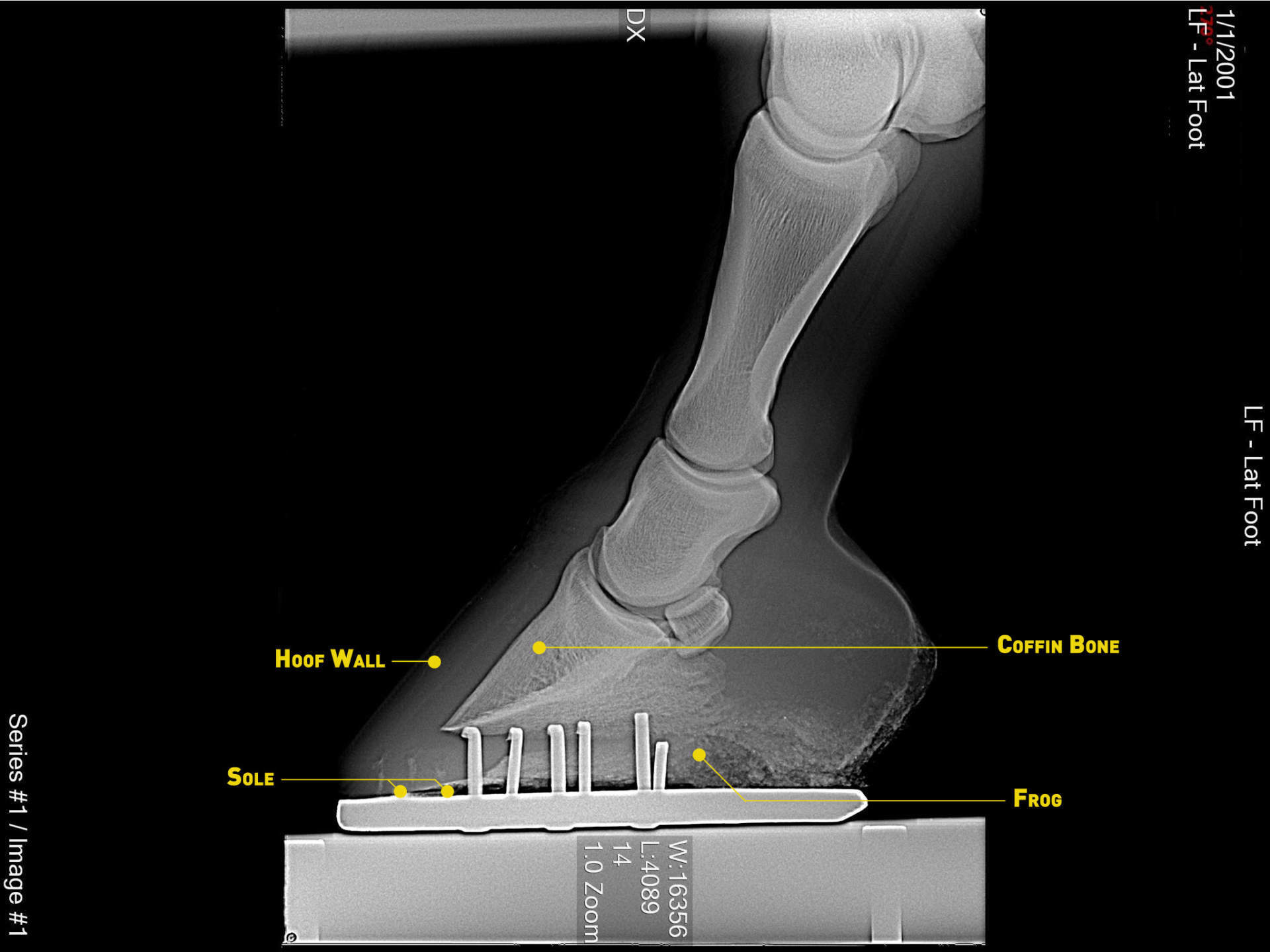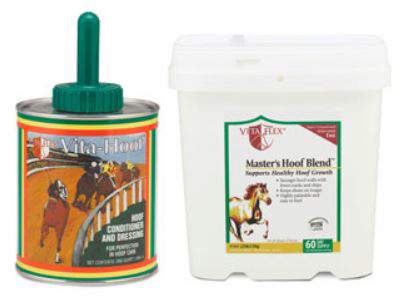Feed the Dog Some Frog Horse
Most people involved with horses have probably heard the saying "No foot, no horse." While there is no question as to the importance of the hoof, this article delves deeper into what the hoof is and what can be done to feed the hoof in order to maintain its health. The hoof is the tough outer covering for the distal phalanx (coffin bone). It is comprised of the hoof wall, sole and frog.

The hoof wall is a type of specialized cells named keratins, which are the main proteins in skin, hair and the hoof. The hoof wall and sole are comprised of "hard" keratins, while the frog is made of "soft" keratins. Hard keratins are rich in disulfide bonds and needed for hoof wall strength, while soft keratins are rich in sulfhydryl bonds and provide some flexibility to the frog.

Articles in both the scientific and popular press, along with the internet, tout the need for biotin to be present in hoof supplements. Biotin is a sulfur-containing B-vitamin that supplies sulfur for sulfhydryl bond formation. Many assume the biotin content in a hoof supplement must be 20 mg or more per unit of intake, however scientific literature has shown hoof benefit in horses fed 15 mg to 30mg per day of biotin. Larger horses, e.g. draft, do require a higher daily intake to see positive changes in the hoof. Equally important and often overlooked is the need for methionine, which is a sulfur-containing dietary essential amino acid that the body converts to cysteine. Sulfur supplied by methionine through cysteine is used in disulfide bond formation, which is critical for hoof wall strength. Biotin and methionine are just two of the nutrients that must be supplied in the diet in order to impact hoof growth. Others include lysine, zinc, copper and calcium; additionally, the horse must be consuming adequate water, energy, protein and other vitamins and minerals to support their daily dietary requirements.
Where does this leave owners with horses who have poor quality hooves and what can be done to help?
First, nutritional deficiencies are not the only culprits. Age, breed, genetics, environment and management also have an impact. Thus, since this is a multifactorial problem, no simple or single answer exists but there are some ways to mitigate or even eliminate some issues. Nutrition may be the easiest factor to correct to improve poor hoof quality. To do so we need to "feed the hoof," which is accomplished by feeding the whole horse. There is not a magical nutrient that will target the hoof, but ensuring the horse is receiving adequate nutrition will often correct some hoof problems. Many horses with hoof issues, even those with adequate nutrition, will benefit from added biotin, methionine, lysine and specific trace minerals (copper and zinc). Unlike feeding some types of supplements where a change in the horse is noticeable in days or weeks, it will take longer to see improvements in hoof growth or quality. Hoof wall grows from the coronet band at a rate of 1/2" to 3/8" per month or about 12 months for a new hoof to form.
Hoof Wall Dryness
While not directly related to nutrition, hoof wall dryness is often seen in horses with a poor quality hoof wall. Dry hooves have an increased tendency for wall cracks and flaking to occur. About 80% of the hoof wall moisture is supplied internally. A study in Australia [Hampson, 2012] reported hoof wall moisture from horses inhabiting arid, partially wet or wet/boggy areas to be 29.6%, 29.5%, and 29.5%, respectively; illustrating hoof wall moisture is fairly consistent regardless of environment. They did find that sole moisture could be altered by soaking the foot for 2 hours or more. Conserving hoof wall moisture may be very important under some circumstances. The use of a quality hoof dressing may help to minimize moisture loss.
Quick Tip Summary:
- Feed the hoof by feeding the horse a balanced diet.
- Be patient! Hoof wall growth is slow, 1/2" to 3/8" per month.
- Quality hoof supplements and topical products can help.
- You cannot change genetics
Feeding the hoof with Vita Flex® Products
Vita Flex's Victory Team of sponsored athletes needs their horse's hooves to be in peak condition in order to compete at the highest levels. Vita Flex offers two products to help the Victory Team maintain proper hoof conditions. Master's Hoof Blend™ provides the Victory Team with key nutrients to aid the overall soundness of the hoof. The highly palatable, alfalfa-based Master's Hoof Blend™includes 20 mg of Biotin to help the soundness of the frog, as well as 1,800 mg of methionine, per daily ounce. Methionine aids in the strengthening of "hard" keratins found in the hoof wall.
Victory Team riders also rely on Vita Flex® Vita-Hoof® topical to retain moisture in the hoof, which is critical in hoof care. Maintaining moisture levels allows for increased movement in the hoof wall, frog and sole in order to decrease wall cracking and sole flakiness associated with dry hooves.
To learn more, visit www.vitaflex.com or call (800) 848-2359.
About Richard G. Godbee, Ph.D., PAS, Dipl. ACAS - Nutrition

Dr. Richard G. Godbee received a Bachelor of Science in Agriculture and a Master of Science in Ruminant Nutrition from the University of Georgia. He received his Ph.D. in Animal Nutrition/Nutritional Biochemistry with an emphasis in equine from Colorado State University. He has numerous publications in peer-reviewed journals and popular press on multiple species.
He has presented papers and given invited talks throughout the United States, Japan, Ireland, England, Germany, Switzerland, Norway, Sweden, Finland, Australia, Mexico and Canada.
Dr. Godbee is a Director of Product Development in Research and Development for Central Garden & Pet. He has served as a faculty or adjunct faculty member of several universities. He has also served on the graduate committees for Master and Ph.D. candidates at numerous universities.
Dr. Godbee's research interest has included the effect of nutrition on immunity and inflammation. He is Board Certified in Animal Nutrition by the American College of Animal Science and has achieved Professional Animal Scientist status in the American Registry of Professional Animal Scientists with a specialty in horses. He is also a member of the American Academy of Veterinary Nutrition. He owns and shows cutting horses at local and national events.
Vita Flex and Vita-Hoof are registered trademarks of Farnam Companies, Inc.
Source: https://www.vitaflex.com/the-arena/hoof-care/feeding-the-hoof
0 Response to "Feed the Dog Some Frog Horse"
Post a Comment